When health professionals collaborate rather than operating in silos, everyone benefits – patients, families and the health system at large. This is a fact supported by ample research evidence. The professionals reap the benefits, too: staff satisfaction and retention are improved through collaboration.
But in the real world, health professionals and departments often slip into silo mentalities. And silos in healthcare, as US cardiologist Laurence Sparling writes, are bad for healthcare. The “cure”, Sparling argues, is integrated healthcare with “cross-silo dialogue” – collaborative healthcare.
But collaboration is a skill that has to be taught. People don’t automatically know how to work in teams. Instead, they have to develop the competencies to do so. Where better to start than in the professional training they receive?
We are lecturers in the Interprofessional Education Unit at the University of the Western Cape in South Africa. For two years, we tracked the development of students doing the first-year interprofessional theoretical module called Primary Health Care.
As we explain in a recent paper, we tweaked the material dimension (the physical and virtual spaces in which learning and teaching occurs) to help students develop some of the core competencies needed for interprofessional work. These include communication with patients, families, community members and health team members; as well as teamwork competencies with all their complexities and demands.
There were immediate and marked improvements in students’ results. We also saw that students became better at giving each other constructive feedback and working together when needed. These are important skills to harness as they work towards becoming health professionals.
Changing things up
Information is available to modern students with the flick of a finger on the screen. This means the curriculum needs to be constantly evaluated to develop an appropriate learning environment.
One model of education shows that learning environments in the health professions are made up of two parts. There’s the psychosocial dimension, itself made up of three components: the personal, social, and organisational.
The material dimension is the second part and was the major focus of our changes. Starting in 2019, we introduced a few substantial changes to the way we taught and evaluated students. (Not knowing, of course, that in 2020 these sorts of adaptations would become necessary in a pandemic.)
Firstly, we converted the course’s traditional classroom test into an online test. Secondly, we introduced changes to the blog in which students had to post responses to a lecture. Students had previously reported that the topics were too rigid and that they therefore simply regurgitated what lecturers had presented.
Health professionals work in teams: their training should prepare them
Another change was to an assignment on how social issues are addressed by organisations in nearby communities. Usually, students had to visit those communities. But many had in the past expressed concern about the costs of travelling to communities – most relied on public transport – and their safety. They also struggled with the logistics of coordinating with team members from various departments.
So we instead invited community members into the classroom to share experiences and stories of their communities. Students were, of course, allowed and encouraged to pose questions to these community members. Students interacted with community members to gain insights into the local indigenous knowledge systems, which represent the unique knowledge passed down through generations within a society. This strengthened their use of polite language and clear communication in important interactions, both important for interprofessional communication.
Marked improvements
These innovations brought about immediate improvements in students’ results. At the end of 2019, following the changes from an in-classroom to an online test, the grade point average improved from 49.94% to 81.54%. While a more modest improvement, the average score for the blog went up by 4.53 percentage points. And finally, in the community assignment, the average grade point improved by nearly 12 percentage points.
A number of factors can be credited for these improvements. For instance, the use of storytelling, as in the meetings with community members, has long been thought to aid learning.
We received positive feedback from students. One said:
(This) is a very interesting module because you get to meet other students doing different courses and learn more about their courses, our lecturer made it fun and interesting too.
Another commented:
The course was interesting and it showed how the inter-sectoral collaboration helps society and the health of many patients.
Applying our lessons
Our advice to others lecturing in this field includes these points:
Help students to get comfortable with online environments. Incorporate technology into the first-year curriculum.
To enhance teamwork, give students the chance to critically and productively confront and reflect on their perspectives from early on in a health professions education programme.
Health professional educators must recognise the emergence of a new, digital paradigm in higher education. A comprehensive and integrated approach to education, research and community engagement is required as the healthcare industry transitions to an interprofessional model, pushing us to dismantle barriers and promote teamwork. Continually evaluating programmes to stay ahead of technological advancements helps prepare them for success.




